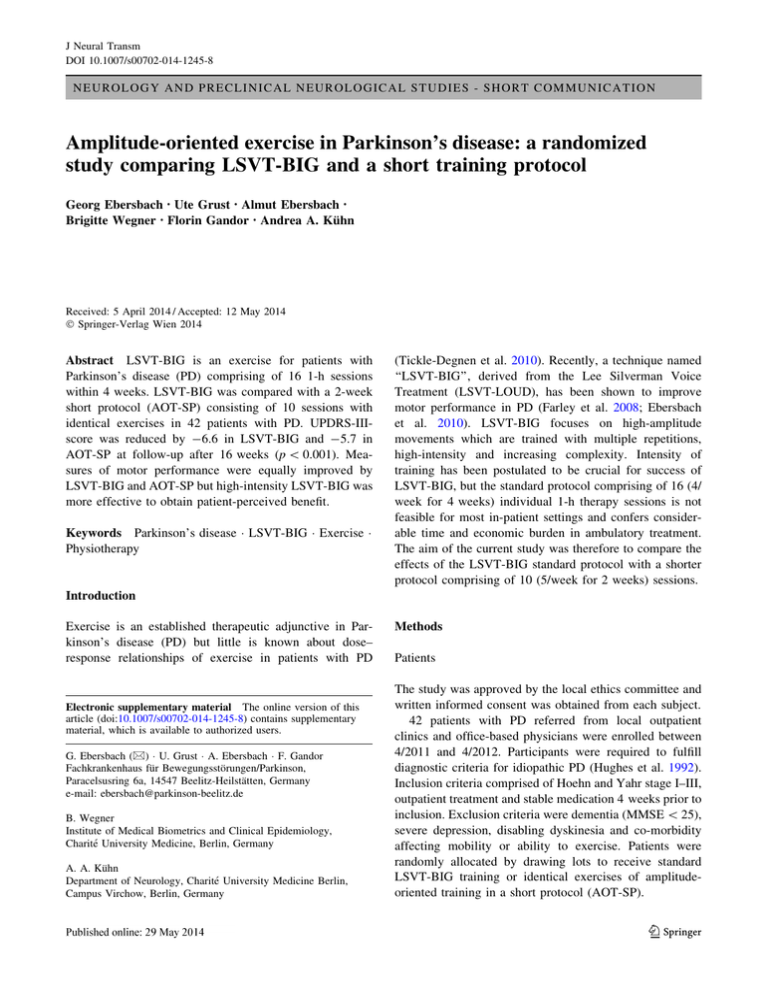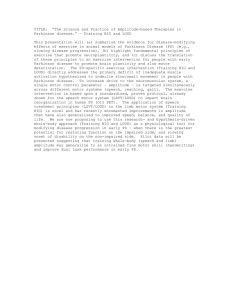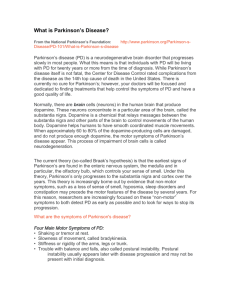Document 10798312
advertisement

J Neural Transm DOI 10.1007/s00702-014-1245-8 NEUROLOGY AND PRECLINICAL NEUROLOGICAL STUDIES - SHORT COMMUNICATION Amplitude-oriented exercise in Parkinson’s disease: a randomized study comparing LSVT-BIG and a short training protocol Georg Ebersbach • Ute Grust • Almut Ebersbach • Brigitte Wegner • Florin Gandor • Andrea A. Kühn Received: 5 April 2014 / Accepted: 12 May 2014 Ó Springer-Verlag Wien 2014 Abstract LSVT-BIG is an exercise for patients with Parkinson’s disease (PD) comprising of 16 1-h sessions within 4 weeks. LSVT-BIG was compared with a 2-week short protocol (AOT-SP) consisting of 10 sessions with identical exercises in 42 patients with PD. UPDRS-IIIscore was reduced by -6.6 in LSVT-BIG and -5.7 in AOT-SP at follow-up after 16 weeks (p \ 0.001). Measures of motor performance were equally improved by LSVT-BIG and AOT-SP but high-intensity LSVT-BIG was more effective to obtain patient-perceived benefit. Keywords Parkinson’s disease LSVT-BIG Exercise Physiotherapy (Tickle-Degnen et al. 2010). Recently, a technique named ‘‘LSVT-BIG’’, derived from the Lee Silverman Voice Treatment (LSVT-LOUD), has been shown to improve motor performance in PD (Farley et al. 2008; Ebersbach et al. 2010). LSVT-BIG focuses on high-amplitude movements which are trained with multiple repetitions, high-intensity and increasing complexity. Intensity of training has been postulated to be crucial for success of LSVT-BIG, but the standard protocol comprising of 16 (4/ week for 4 weeks) individual 1-h therapy sessions is not feasible for most in-patient settings and confers considerable time and economic burden in ambulatory treatment. The aim of the current study was therefore to compare the effects of the LSVT-BIG standard protocol with a shorter protocol comprising of 10 (5/week for 2 weeks) sessions. Introduction Exercise is an established therapeutic adjunctive in Parkinson’s disease (PD) but little is known about dose– response relationships of exercise in patients with PD Electronic supplementary material The online version of this article (doi:10.1007/s00702-014-1245-8) contains supplementary material, which is available to authorized users. G. Ebersbach (&) U. Grust A. Ebersbach F. Gandor Fachkrankenhaus für Bewegungsstörungen/Parkinson, Paracelsusring 6a, 14547 Beelitz-Heilstätten, Germany e-mail: ebersbach@parkinson-beelitz.de B. Wegner Institute of Medical Biometrics and Clinical Epidemiology, Charité University Medicine, Berlin, Germany A. A. Kühn Department of Neurology, Charité University Medicine Berlin, Campus Virchow, Berlin, Germany Methods Patients The study was approved by the local ethics committee and written informed consent was obtained from each subject. 42 patients with PD referred from local outpatient clinics and office-based physicians were enrolled between 4/2011 and 4/2012. Participants were required to fulfill diagnostic criteria for idiopathic PD (Hughes et al. 1992). Inclusion criteria comprised of Hoehn and Yahr stage I–III, outpatient treatment and stable medication 4 weeks prior to inclusion. Exclusion criteria were dementia (MMSE \ 25), severe depression, disabling dyskinesia and co-morbidity affecting mobility or ability to exercise. Patients were randomly allocated by drawing lots to receive standard LSVT-BIG training or identical exercises of amplitudeoriented training in a short protocol (AOT-SP). 123 G. Ebersbach et al. Interventions Five physiotherapists certified as LSVT-BIG instructordelivered training in two outpatient facilities (Berlin and Beelitz). Patients assigned to LSVT-BIG standard protocol received 16 1-h sessions (4/week for 4 weeks) and patients allocated to AOT-SP received 10 1-h sessions (5/week for 2 weeks). LSVT-BIG exercises have previously been described in detail (Farley et al. 2008). In brief, 50 % of exercises consist of standardized whole-body exercises involving maximal amplitude, repetitive multidirectional movements (e.g., stepping and reaching) and stretching. The second half of exercise includes goal-directed activities of daily living (ADL) according to individual needs and preferences (see details in supplementary files). BIG is delivered one-to-one with intensive motivation and feedback by the instructor. Patients are taught to use bigger movements in routine activities to provide continuous exercise in everyday movements. Assessment procedures Participants were assessed immediately before starting active treatment (baseline) and 16 weeks after baseline (follow-up). In addition, explorative assessments were performed 4 weeks prior to baseline and immediately after completing treatment. The primary efficacy measure was the difference in change from baseline in UPDRS-III-score between treatment groups at week 16. For blinded assessment of the primary variable, patients were videotaped while performing all UPDRS-III items. Videos were then rated by an experienced rater blinded to group allocation and time point of examination. Rating of rigidity was facilitated by brief comments from the person performing the physical examination. Secondary outcome variables included differences in change from baseline to week 16 for the following parameters: clinical global impression of change (CGI-C, patient/physician), Parkinson’s disease questionnaire (PDQ-39) (Jenkinson et al. 1997), timed up-and-go (TUG), 10-m walk, 6-min walk, assessment of step length with gait analysis based on accelerometric recordings [RehaWatchÒ gait analysis, HASOMED GmbH, Magdeburg, Germany (Schwesig et al. 2010)] and arm mobility using the box and block test (Mathiowetz et al. 1985). All tests were carried out during the medication ‘‘ON’’ period. Data analysis Group (LSVT-BIG vs. AOT-SP) 9 time (baseline vs. week 16) analysis of variance was used to assess treatment 123 effects and interactions between groups. Within-group effects were analyzed with paired t tests. Chi-square tests were used to compare CGI-C between groups. Alpha level was set at 0.05 and all statistical tests were two-sided. Outcome analyses were conducted on a per-protocol-basis using SPSS software. The study was powered to detect a difference of four points in the UPDRS-III-score change with a power of 80 %, assuming a standard deviation of four at an alpha level of 0.05. The power analysis determined that 17 patients per group were needed. Results Of 42 patients randomly assigned for treatment (21 in each group), 34 subjects (17 per group) completed the study and were available for follow-up at week 16. Dropouts were due to disease not related to therapy (4), withdrawal of consent (2) and non-compliance with the study protocol (2). In the final sample male/female ratio was 11/6 in LSVTBIG and 13/4 in AOT-SP, respectively. Mean age was 66.4 years in both groups (SD 6.9 in LSVT-BIG, 6.7 in AOT-SP). Disease duration was 4 years (SD 2.4) in LSVTBIG and 4.2 (2.7) in AOT-SP. At baseline, mean levodopa equivalence daily dosage (LEDD) was 557 mg in LSVTBIG and 429 mg in AOT-SP. Adjustments of dopaminergic medication between baseline and week 16 occurred in two subjects in LSVT-BIG and one subject in AOT-SP, resulting in non-significant changes of mean LEDD (548 vs. 445 mg). There were no adverse events attributable to the intervention. Efficacy ANOVA for UPDRS-III-score showed effects of time (p \ 0.001, F 120.16) and no time 9 group interactions (p 0.410, F 0.698). There was a group effect (p 0.0114) that was not reproduced (p 0.248, F 1.385) when baseline UPDRS-III-scores were included as a covariate (ANCOVA). Similarly, ANOVA showed effects of time for TUG (p \ 0.001, F 33.12), 10-m walk (p 0.001, F 13.59), 6-min walk (p \ 0.001, F 18.01), step length (p \ 0.001, F 22.67) and arm mobility (p \ 0.001, F 38.67) and no group effects or time 9 group interactions for these measures. Comparisons between baseline and follow-up measures for each group are shown in Table 1. PDQ-39-total-scores at baseline were 35.53 (16.1) in LSVT-BIG and 29.3 (13.2) in AOT-SP and did not meet the distributional assumptions for parametric analysis. Changes at follow-up were numerically higher in LSVTBIG (-3.71 vs. -1.5) but Wilcoxon’s matched pairs tests Amplitude-oriented exercise in PD Table 1 Changes in outcome measures following intervention Baseline Follow-up Change 95 % CI p UPDRS-III LSVT-BIG 18.2 (3.6) 11.6 (5.2) -6.6 -8.5/-4.8 \0.001 AOT-SP 22.0 (5.4) 16.3 (5.1) -5.7 -7.2/-4.2 \0.001 LSVT-BIG 9.4 (1.7) 8.1 (1.3) -1.3 -1.8/-0.8 \0.001 AOT-SP 9.2 (1.2) 8.1 (1.5) -1.1 -1.8/-0.4 0.005 \0.001 TUG (s) Walk 10 m (s) LSVT-BIG 7.3 (1.4) 5.8 (1.0) -1.5 -2.1/-0.8 AOT-SP 7.6 (2.8) 6.1 (0.8) -1.5 -3.1/0.1 0.060 Walk 6 min (m) LSVT-BIG 488 (80) 545 (89) 58 31/84 \0.001 AOT-SP 520 (78) 552 (119) 32 -4/68 0.081 Box block test 101.9 (13.3) 110.8 (14.6) 8.8 4.3/13.1 \0.001 97.7 (13.4) 108.6 (11.3) 10.9 5.6/16.1 \0.001 LSVT-BIG 140.8 (16.1) 155.0 (20.8) 14.2 6.5/21.9 0.001 AOT-SP 140.9 (16.5) 151.1 (13.6) 10.3 2.3/18.2 0.015 LSVT-BIG AOT-SP Step length AOT-SP amplitude-oriented training-short protocol, TUG timed up-and-go performed separately for each group did not show effects of treatment (LSVT-BIG: p 0.351; AOT-SP: p 0.534). Patient CGI-C differed between groups (p 0.005, Fisher’s exact test) with 70.6 % of patients reporting to be ‘‘much improved’’ or ‘‘very much improved’’ in LSVTBIG and only 17.6 % in AOT-SP (Fig. 1). A corresponding tendency was also found in physician CGI-C (68.8 vs. 28.6 %, p 0.090). Discussion In the present prospective controlled, rater-blinded study, LSVT-BIG led to improved motor performance in patients Fig. 1 Patients clinical global impression of change from baseline to week 16 (in percent). LSVT-BIG standard protocol, AOT-SP amplitude oriented training short protocol with PD that was comparable to the effect reported in our previous study (Ebersbach et al. 2010). Changes in motor assessments did not differ between patients following the standard LSVT-BIG protocol and those receiving a smaller amount of training sessions. These findings oppose an expected dose dependency of therapy that would have favored the standard LSVT-BIG protocol. In contrast to motor examination, clinical global impression strongly favored the standard protocol. The dependency of motor performance in PD on attention and situational circumstances is a possible reason for this discrepancy. It has been shown that patients with PD walk faster and with larger steps when concentrating on their performance but return to bradykinetic gait when attention is distracted from movement execution (Morris et al. 1996; Rochester et al. 2010). The underlying problem is that skill acquisition may be preserved but the ability to transfer skills to automatic routines is impaired (Rochester et al. 2010; Wu and Hallett 2008). Motor assessments in the present study were, as usual, carried out in a laboratory environment. It is therefore conceivable that patients were more attentive towards motor performance under these circumstances. Evidently, patients in the short protocol were enabled to perform highamplitude movements as exercised during the LSVTBIG training sessions while being under examination. Yet, the reduced training intensity of AOT-SP may not have been sufficient enough to obtain the main goal of LSVT-BIG, i.e., recalibrating movement amplitude to secure improved motor performance in 123 G. Ebersbach et al. routine activities without attentiveness towards movement execution (Farley et al. 2008). Results from a PET study showed that LSVT is associated with a shift of cortical motor activation towards subcortical areas suggesting that more ‘‘automatic’’ motor processing can be achieved (Liotti et al. 2003). Covert observation of routine activities would be necessary to corroborate the hypothesis that only the standard LSVT-BIG and not the short protocol provides meaningful impact on ‘‘automatic’’ routine motor activities, as suggested by the difference of CGI between groups. A limitation of the present approach is that we cannot exclude that nonspecific factors such as more intense attention to the patient in the LSVTBIG group or biased expectations of patients and therapists were responsible for differences in CGI. Furthermore, generalizability of our findings is limited by sample size. Further studies addressing the possible bias inferred by influence of laboratory conditions on motor performance in PD are warranted. In addition, there is need to focus on effects of exercise on patient-reported outcomes in PD as emphasized in a recent Cochrane review (Tomlinson et al. 2012). In spite of comparable outcome of clinician-rated UPDRS scores and laboratory motor assessments, we recommend to deliver LSVT-BIG according to the standard protocol since shorter training routines are less likely to provide patient-perceived improvement. Acknowledgments We thank Deutsche Parkinson Gesellschaft for financial and organizational support. We also thank Heike Unger and physiotherapists in Beelitz-Heilstätten for skillfully exercising participants. This work was supported by an unrestricted Grant from Deutsche Parkinson Gesellschaft. Conflict of interest The authors have no financial disclosures to make and no conflict of interest to report with respect to the research reported in this manuscript. 123 References Ebersbach G, Ebersbach A, Edler D, Kaufhold O, Kusch M, Kupsch A et al (2010) Comparing exercise in Parkinson’s disease—the Berlin BIG study. Mov Disord 25:1902–1908 Farley BG, Fox CM, Ramig L, Farland DC (2008) Intensive amplitude-specific therapeutic approaches for Parkinson’s disease. Topics Geriatr Rehabil 24:99–114 Hughes AJ, Ben-Shlomo Y, Daniel SE, Lees AJ (1992) What features improve the accuracy of clinical diagnosis in Parkinson’s disease: a clinicopathologic study. Neurology 42:1142–1146 Jenkinson C, Fitzpatrick R, Peto V, Greenhall R, Hyman N (1997) The Parkinson’s disease questionnaire (PDQ-39): development and validation of a Parkinson’s disease summary index score. Age Ageing 26:353–357 Liotti M, Ramig LO, Vogel D, New P, Cook CI, Ingham RJ et al (2003) Hypophonia in Parkinson’s disease: neural correlates of voice treatment revealed by PET. Neurology 60:432–440 Mathiowetz V, Volland G, Kashman N, Weber K (1985) Adult norms for the box and block test of manual dexterity. Am J Occup Ther 39:386–391 Morris ME, Iansek R, Matyas TA, Summers JJ (1996) Stride length regulation in Parkinson’s disease. Normalisation strategies and underlying mechanisms. Brain 119:551–568 Rochester L, Baker K, Hetherington V, Jones D, Willems AM, Kwakkel G et al (2010) Evidence for motor learning in Parkinson’s disease: acquisition, automaticity and retention of cued gait performance after training with external rhythmical cues. Brain Res 1319:103–111 Schwesig R, Kauert R, Wust S, Leuchte S (2010) Reliability of the novel gait analysis system RehaWatch. Biomed Tech (Berl) 55:109–115 Tickle-Degnen L, Ellis T, Saint-Hilaire MH, Thomas CA, Wagenaar RC (2010) Self-management rehabilitation and health-related quality of life in Parkinson’s disease: a randomized controlled trial. Mov Disord 25:194–204 Tomlinson CL, Patel S, Meek C, Herd CP, Clarke CE, Stowe R (2012) Physiotherapy intervention in Parkinson’s disease: systematic review and meta-analysis. BMJ 345:e5004. doi:10.1136/ bmj.e5004 Wu T, Hallett M (2008) Neural correlates of dual task performance in patients with Parkinson’s disease. J Neurol Neurosurg Psychiatry 79:760–766





